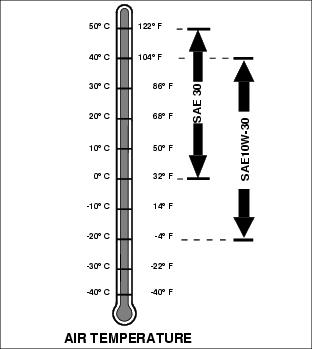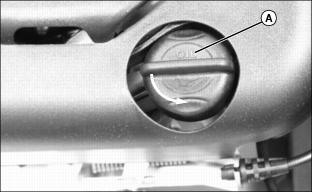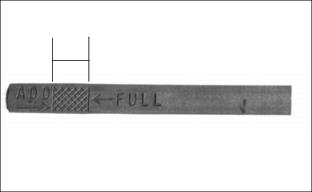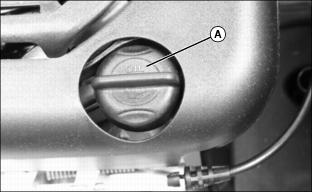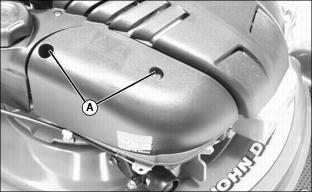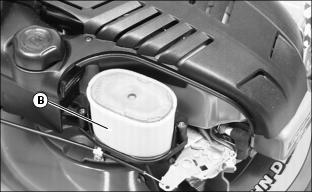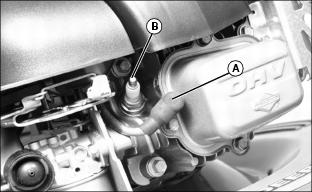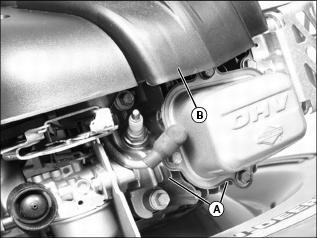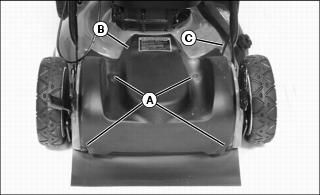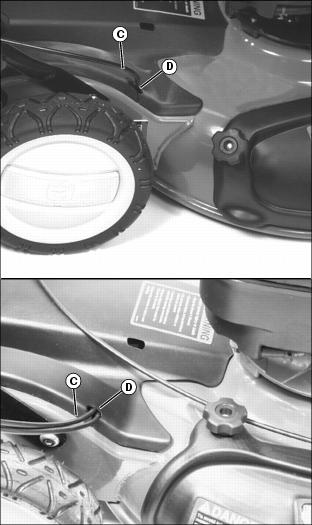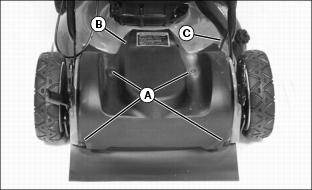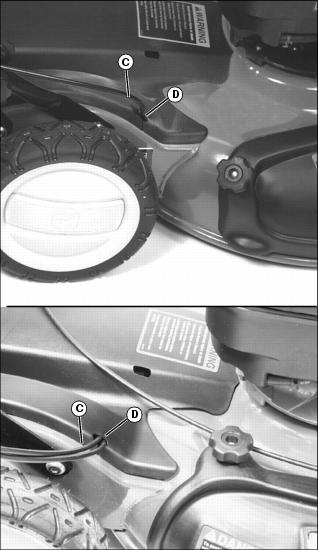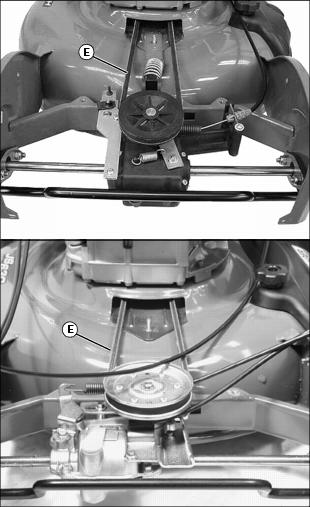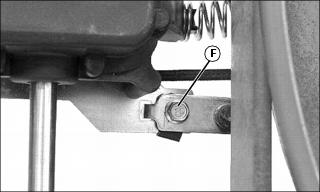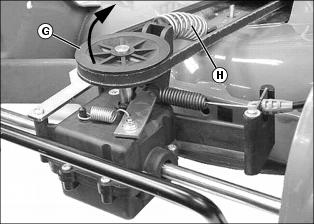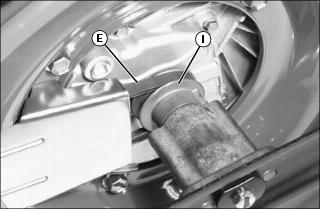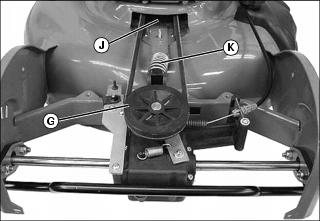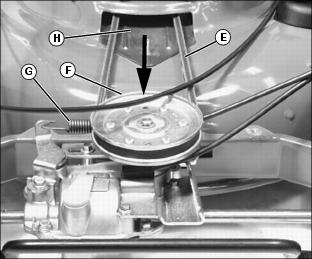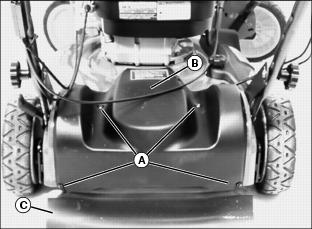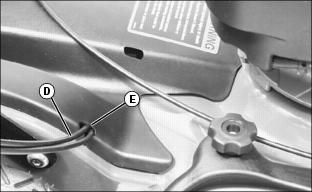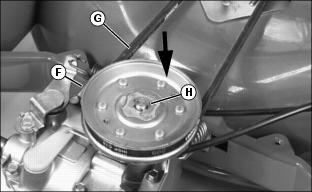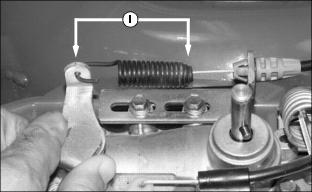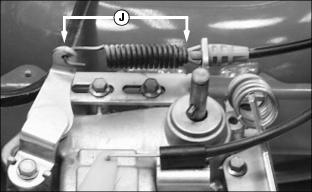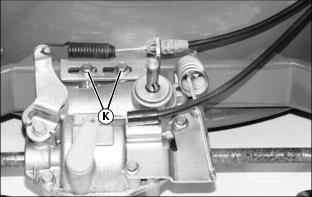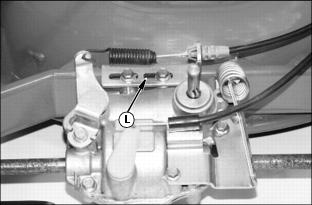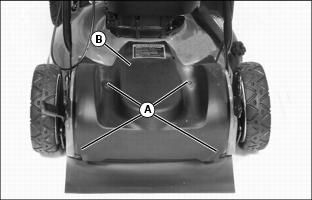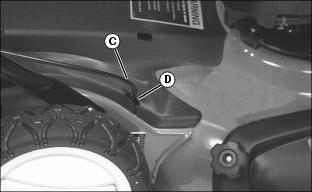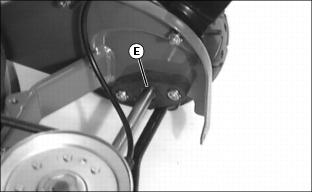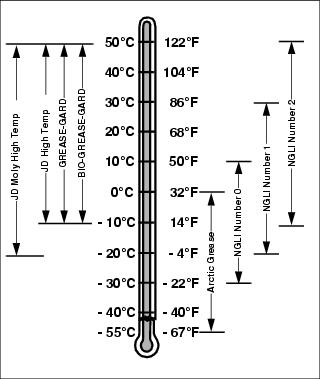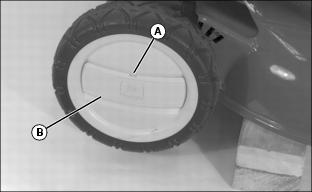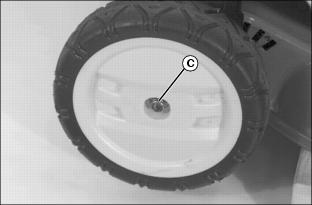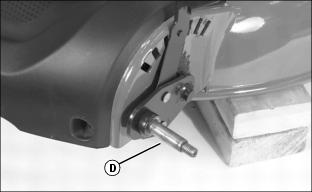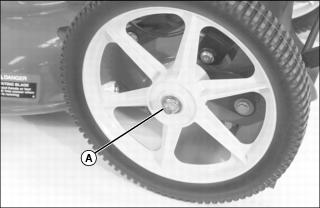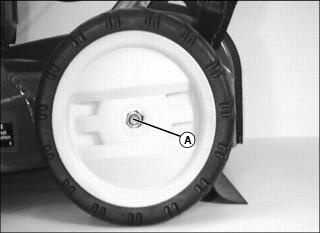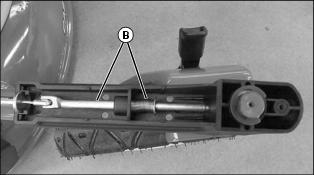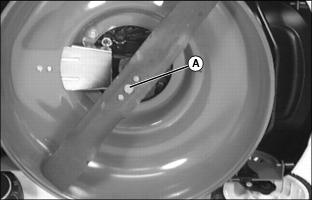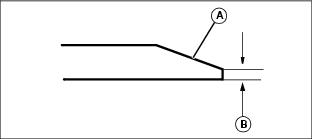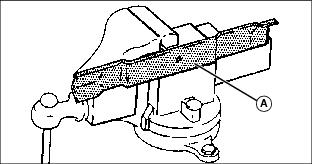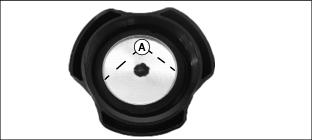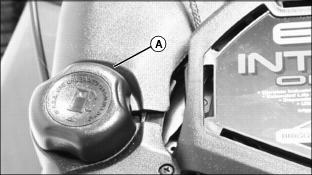
Service
Engine Warranty Maintenance Statement
Maintenance, repair, or replacement of the emission control devices and systems on this engine, which are being done at the customers expense, may be performed by any non road engine repair establishment or individual. Warranty repairs must be performed by an authorized John Deere dealer.
Adjusting Carburetor
NOTE: Carburetor is calibrated by the engine manufacturer and should not require any adjustments.
If engine is operated at altitudes above 1829 m (6,000 ft), some carburetors may require a special high altitude main jet. See your John Deere dealer.
If engine is hard to start or runs rough, check the Troubleshooting section of this manual.
After performing the checks in the troubleshooting section and your engine is still not performing correctly, contact your John Deere dealer.
Avoid Fumes
Engine Oil
Use oil viscosity based on the expected air temperature range during the period between oil changes.
The following John Deere oils are preferred:
The following John Deere oils are also recommended, based on their specified temperature range:
Other oils may be used if above John Deere oil is not available, provided they meet one of the following specifications:
ˇ SAE 10W-30-API Service Classification SG or higher
ˇ SAE 30-API Service Classification SC or higher
Checking Engine Oil
1. Park mower on level surface and stop engine.
2. Turn oil dipstick (A) 1/4 turn counterclockwise and remove from the filler tube.
3. Wipe dipstick off with a clean cloth.
4. Install dipstick. Turn oil dipstick (A) 1/4 turn clockwise and tighten.
5. Remove dipstick. Check oil level. Oil should be between ADD and FULL marks shown on dipstick, not above FULL mark.
7. Install and tighten dipstick.
Changing Engine Oil
1. Park mower on a level surface.
2. Drain fuel from tank or run engine until fuel tank is empty or near empty.
3. Stop engine and disconnect spark plug wire.
4. Turn oil dipstick (A) 1/4 turn counterclockwise and remove from the oil filler tube.
5. Insert a plastic drain tube firmly inside oil filler tube opening (B).
6. Place a drain pan on the left side of the mower.
7. Turn mower onto its left side.
8. Allow engine oil to drain from the dipstick filler tube location into the drain pan.
9. After oil has drained, return mower to an upright position.
10. Remove plastic drain tube.
11. Clean area around filler tube.
12. Add oil through dipstick filler tube. Check oil level and continue to add oil to FULL mark.
ˇ To check oil level, wipe dipstick, install dipstick and tighten, then remove dipstick and read level.
13. Install and tighten dipstick.
Checking and Cleaning Air Cleaner Element
1. Park machine safely. (See Parking Safely in the Safety Section.)
3. Disconnect spark plug wire.
4. Clean dirt and debris from the air cleaner cover.
5. Loosen screws (A), and remove cover.
6. Inspect the foam precleaner (B) without removing it. If the foam precleaner is dirty:
a. Remove it from the filter carefully, leaving the paper element in the air cleaner housing.
b. Wash precleaner in a solution of warm water and liquid detergent.
c. Rinse precleaner thoroughly. Squeeze out excess water in a dry cloth until precleaner is completely dry.
7. Inspect the paper element without removing it. If the paper element is damaged or dirty, remove and replace it with a new element.
8. Clean air cleaner base carefully, preventing any dirt from falling into carburetor.
9. Install foam precleaner onto paper element and install into air cleaner base.
10. Close cover and tighten screws. Do not overtighten.
Cleaning and Gapping Spark Plug
1. Disconnect spark plug wire (A). Remove spark plug (B).
2. Carefully wire brush carbon from plug. Do not clean it with abrasives in a machine.
3. Inspect plug for damage. Replace damaged plug.
4. Adjust gap: 0.51 mm (0.02 in.).
5. Install and tighten plug to 20 Nˇm (15 lb-ft).
Cleaning Engine Cooling Fins
1. Park mower on level surface and stop engine.
3. Disconnect spark plug wire.
4. Clean fins (A) with brush, rag, or compressed air.
5. Blow compressed air under shroud (B).
Cleaning Drive Belt and Transmission Area (JS61, JS63 and JS63C)
1. Remove hardware (A) and belt shield (B).
2. Remove control cables (C) from belt shield notch (D).
3. Remove clippings from belt area and top of the transmission.
4. Slide control cable into belt shield notch.
Checking and Replacing Drive Belt
ˇ Prevent burns by allowing engine to cool. ˇ Wear protective gloves when service is performed within the mower blade area. |
1. Stop engine and disconnect spark plug wire.
2. Remove hardware (A) and belt shield (B).
3. Remove control cables (C) from belt shield notch (D).
4. Inspect belt (E) for excessive wear or damage.
To Replace Drive Belt (JS61):
NOTE: On model JS61 only, the anti-rotation bracket must be removed prior to pushing the drive sheave forward to remove the drive belt.
Picture Note: View is from underside of differential.
1. Remove cap screw (F) and anti-rotation bracket.
2. Push drive sheave (G) forward to relieve spring tension on belt.
NOTE: Tension spring (H) may come loose when belt is removed.
3. Remove belt from drive sheave.
4. Move belt into underside of mower deck.
5. Turn mower onto its left side.
6. Remove drive belt (E) from blade sheave (I).
7. Install new drive belt to blade sheave.
9. Insert belt through deck opening (J).
10. Install tension spring (K) if removed.
11. Check that drive belt is installed on engine sheave.
12. Push drive sheave (G) forward and install belt to sheave.
13. Install anti-rotation bracket and secure with cap screw.
14. Slide control cables into belt shield notch.
15. Install belt shield and connect spark plug wire.
To Replace Drive Belt (JS63 and JS63C):
1. Push down on front of drive sheave (F) to relieve spring tension on belt (E) and remove drive belt.
NOTE: Tension spring (G) may come loose when drive belt is removed. Install after you replace belt.
2. Move belt through deck opening (H) into underside of mower deck.
3. Turn mower on its left side.
4. Remove drive belt (E) from blade sheave (I) and mower blade.
5. Install new drive belt over mower blade and onto blade sheave.
6. Insert belt back through deck opening (H).
7. Return mower to upright position.
8. Install tension spring (G) if removed.
9. Push down on front of drive sheave (F) and install belt on sheave.
10. Slide control cables into belt shield notch.
11. Install drag flap and belt shield with screws.
Adjusting Transmission Cable (JS63 and JS63C)
1. Park mower on level surface and stop engine.
2. Disconnect spark plug wire.
3. Remove screws (A), belt shield (B), and drag flap (C).
4. Remove control cables (D) from belt shield notch (E).
5. Push down on front of drive sheave (F) to relieve spring tension on belt and remove drive belt (G).
6. Remove E-clip (H) and drive sheave.
7. Measure the clutch spring length (I) in the relaxed position. Record this value.
8. Engage the traction clutch lever (at handle bar) and measure the spring length in the extended position (J).
ˇ The spring extension length (the difference between I and J measurements) must be 10 mm (0.390 in.).
9. Use 8 mm wrench to loosen (but not remove) cable mount bracket capscrews (K) to adjust spring extension.
NOTE: For transmission clutch to operate properly, there must be a certain amount of spring pressure or the transmission will slip and not drive the wheels.
10. Slide bracket (L) distance needed to obtain 10 mm (0.390 in.) spring extension length (difference between length of relaxed spring and length of extended spring). Tighten capscrews.
11. Repeat steps 7-8 to verify 10 mm (0.390 in.) spring extension length.
12. Install cables through notch in belt shield.
13. Install drag flap and belt shield with screws.
15. Start engine and check that transmission is operating properly.
NOTE: Make sure transmission immediately disengages when traction clutch lever is released.
16. If transmission does not disengage when lever is released, reduce spring extension length and check that transmission is operating properly.
Lubricating Drive Shaft Hub Bushings (JS61, JS63 and JS63C)
Service Interval: Lubricate drive shaft hub bushings every 25 hours or once a year.
1. Remove hardware (A) and belt shield (B).
2. Remove control cable (C) from belt shield notch (D).
3. Tilt mower slightly to one side. Lubricate driveshaft hub bushing (E) with a few drops of light weight motor oil. Repeat procedure for other side.
4. Slide control cables (C) into belt shield notch (D).
Grease
Use grease based on the expected air temperature range during the service interval.
The following greases are preferred:
ˇ John Deere Moly High Temperature EP Grease.
ˇ John Deere High Temperature EP Grease.
Other greases may be used are:
ˇ SAE Multipurpose EP Grease with 3 to 5 percent molybdenum disulfide.
ˇ Greases meeting Military Specification MIL-G-10924C may be used as arctic grease.
Lubricate Mower Axles
Front Axle (JS60H)
1. Tip mower to one side to elevate mower wheels slightly off the ground. Use a wood block to keep side of mower in a raised position.
2. Insert screwdriver in slot (A) to remove plastic hubcap (B).
4. Remove wheel from each axle.
5. Apply a light coating of grease to axle (D).
6. Install wheel, hardware and hubcap.
8. Repeat procedure on other side of mower.
Rear Axle (JS60H)
Rear wheels are equipped with sealed bearings (A). Do not lubricate the rear axles.
Rear Axle (JS61, JS63, JS63C)
1. Tip mower to one side to raise mower wheels slightly off ground. Use wood blocks to keep side of mower raised.
2. Remove hubcap and locknut (A).
3. Apply a light coating of multi-purpose grease to each axle (B).
4. Install wheels, hardware and hubcaps.
5. Lower mower. Repeat procedure for other rear wheel.
Greasing Caster Wheel Spindle (JS63C)
1. Grease caster wheel spindle hole (A) with multi-purpose grease.
2. Repeat for other castor wheel.
Cleaning Caster Wheel Pin (JS63C)
1. Remove cover (A) on caster wheel.
2. Clean dirt from around and on pin and spring (B).
Servicing Mower Blades
ˇ Disconnect spark plug wire to prevent accidental startup. ˇ Mower blades are sharp. Always wear gloves when handling or working near blades. |
NOTE: Sharpened edges on blade tips must face upward when installing blade.
Removing Mower Blades
1. Remove bolt (A), washer and blade.
2. Inspect blade; sharpen, balance or replace blade as necessary.
Installing Mower Blades
1. Lubricate bolt threads lightly with a general purpose grease or oil to prevent rusting and seizing.
2. Tighten bolt (A) to 75 Nˇm (55 lb-ft).
Sharpening Blades
ˇ Sharpen blade with grinder, hand file or electric blade sharpener
ˇ Keep original bevel (A) when you grind.
ˇ Blade should have 0.40 mm (1/64 in.) cutting edge (B).
ˇ Balance blades before installing.
Balancing Blades
2. Put blade (A) on a nail in vise. Turn blade to horizontal position.
3. Check balance. If blade is not balanced, the heavy end of blade will drop.
4. Grind bevel of heavy end. Do not change bevel.
5. Install blade, washer, and bolt. Tighten bolt to 75 Nˇm (55 lb-ft).
Cleaning Fuel Cap Vents
2. Check two vents (A) under metal ring and vent in top, center of cap.
3. Clean cap and vents in nonflammable solvent. Let cap dry.
Filling Fuel Tank
Use regular grade 87 octane unleaded fuel.
Add John Deere fuel stabilizer to fuel before using it in your machine to prevent engine damage due to stale fuel. Follow directions on stabilizer container.
1. Stop engine. If engine is hot let it cool several minutes before you add fuel.
2. Remove grass clippings and other trash from tank area.
